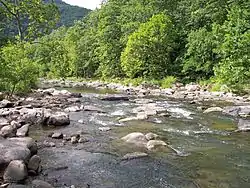| Bluestone River | |
|---|---|
 Bluestone River in Pipestem Resort State Park | |
| Location | |
| Country | United States |
| State | Virginia, West Virginia |
| Counties | Tazewell VA, Mercer WV, Summers WV |
| Physical characteristics | |
| Source | East River Mountain |
| • location | Tazewell County, Virginia |
| • coordinates | 37°10′19″N 81°24′58″W / 37.17194°N 81.41611°W[1] |
| • elevation | 3,589 ft (1,094 m)[2] |
| Mouth | New River in Bluestone Lake |
• location | Summers County, West Virginia |
• coordinates | 37°36′44″N 80°54′52″W / 37.61222°N 80.91444°W[1] |
• elevation | 1,424 ft (434 m)[1] |
| Length | 77 mi (124 km)[3] |
| Discharge | |
| • location | Pipestem, West Virginia[4] |
| • minimum | 7 cu ft/s (0.20 m3/s)daily mean (September 22, 1955) |
| • maximum | 19,300 cu ft/s (550 m3/s)peak (April 5, 1977) |
| Basin features | |
| Progression | Bluestone River → New River → Kanawha River → Ohio River → Mississippi River → Gulf of Mexico |
| Tributaries | |
| • left | Little Bluestone River |
| • right | Blacklick Creek (West Virginia), Brush Creek (West Virginia), Pipestem Creek |
| Type | Scenic |
| Designated | October 26, 1988 |
The Bluestone River is a tributary of the New River, 77 mi (124 km) long, in southwestern Virginia and southern West Virginia in the United States.[3] Via the New, Kanawha and Ohio rivers, it is part of the watershed of the Mississippi River. An 11 mi (18 km) portion of its lower course in West Virginia is designated as the Bluestone National Scenic River.[5]
Course
The Bluestone rises on East River Mountain in Tazewell County, Virginia and flows generally northeastwardly through Mercer and Summers counties in West Virginia, passing the towns of Bluefield in Virginia and Bramwell and Montcalm in West Virginia.[6][7] It joins the New River about 4 mi (6.4 km) south of Hinton as part of Bluestone Lake,[3] which is formed by a U.S. Army Corps of Engineers dam on the New. The Bluestone's National Scenic River segment is located mostly in Summers County, as is Pipestem Resort State Park, which lies along a gorge formed by the river.[7][8]
Pollution
The Bluestone has been compromised by PCB contamination, largely left over from former coal mining activities. As a result of this contamination, Virginia does not recommend eating any carp in the upstream vicinity of Bluefield, Virginia.[9] West Virginia recommends eating no more than one meal of carp per month.[10]
In Virginia, the state Department of Environmental Quality does not recommend any contact recreation (such as swimming or wading) in the Bluestone due to high levels of fecal coliform bacteria.[11]
Little Bluestone River
The Little Bluestone River[12] is a minor tributary of the Bluestone in Summers County, fewer than 10 mi (15 km) in length from its formation by the confluence of two streams, White Oak Branch and Jumping Branch.[7]
Variant names
According to the Geographic Names Information System, the Bluestone River has also been known as:[13]
- Big Bluestone River
- Blue Stone Creek
- Blue Stone River
- Bluestone Creek
Native American names have included the following:
- Mec-ce-ne-ke-ke-ce-pe-we
- Mec-cen-ne-ke-ke
- Mo-mom-ga-sen-eka-ce-pe
See also
References
- 1 2 3 "Bluestone River". Geographic Names Information System. United States Geological Survey, United States Department of the Interior. Retrieved 2004-04-24.
- ↑ "Bluestone River Source". Elevation Query. U.S. Geological Survey. Retrieved 2008-04-24.
- 1 2 3 Columbia Gazetteer of North America entry Archived March 25, 2005, at the Wayback Machine
- ↑ "USGS 03179000 BLUESTONE RIVER NEAR PIPESTEM, WV". National Water Information System. U.S. Geological Survey. Retrieved 2010-03-16.
- ↑ Bluestone National Scenic River website
- ↑ DeLorme (2005). Virginia Atlas & Gazetteer. Yarmouth, Maine: DeLorme. ISBN 0-89933-326-5
- 1 2 3 DeLorme (1997). West Virginia Atlas & Gazetteer. Yarmouth, Maine: DeLorme. ISBN 0-89933-246-3
- ↑ Pipestem Resort State Park website
- ↑ "PCBs in the Bluestone River" (PDF). Virginia Department of Environmental Quality. Archived (PDF) from the original on 2011-04-09. Retrieved April 13, 2010.
- ↑ "West Virginia Fish Consumption Advisories". West Virginia Department of Health and Human Resources. Archived from the original on March 7, 2010. Retrieved April 13, 2010.
- ↑ "Fecal Bacteria and General Standard Total Maximum Daily Load Development for the Bluestone River" (PDF). Virginia Department of Environmental Quality. September 2004. Archived from the original (PDF) on 2012-03-04. Retrieved April 13, 2010.
- ↑ U.S. Geological Survey Geographic Names Information System: Little Bluestone River
- ↑ U.S. Geological Survey Geographic Names Information System: Bluestone River